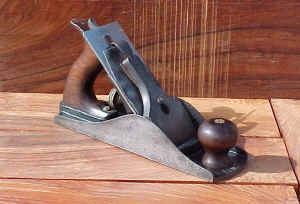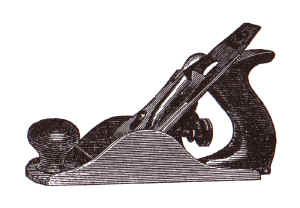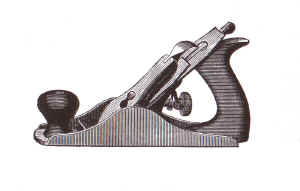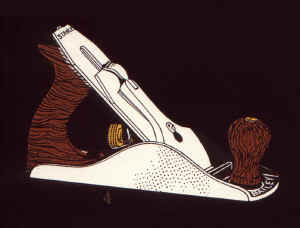Stanley No. 4-1/2 & 4-1/2 C Smoothing Planes

Stanley No. 4-1/2 Smoothing Plane (Type 10) 4

1870 Catalog Image of Bailey Smoothing Plane Showing Beaded Low Front Knob 2

1888 Catalog Image of Bailey Smoothing Plane Showing Lateral Adjustment 2

1923 Catalog Image of Bailey Smoothing Plane Showing High Front Knob3
Manufactured1: 1869 to 1984
Patents1::
- Leonard Bailey's 8/31/1858 (lever cap)
- Leonard Bailey's 8/6/1867 (cutter adjustment)
- Leonard Bailey's 12/24/1867 (thin cutter & cap iron)
- Josef Nicht's 2/8/1876 (lateral)
- Justus A.Traut's 10/21/1884 (improved lateral)
- Justus A.Traut's 7/24/1888 (disc pivot lateral)
- Edmund A. Schade's 9/3/1895 (fine frog adjustment)
- Henry Richard's 3/25/1902 (improved frog)
- Alix W. Stanley's 8/19/1902 (frog receivers)
- Edmund A. Schade's 4/19/1910 (improved frog adjustment)
- Earl V. Higbee's 7/18/1933
(lever cap)
Dimensions1:
9 inches long
Cutter1: 2
inches wide
Construction1:
cast iron, rosewood handle and knob
Finsh1:
Japanned
User Info1: General purpose bench plane. Just one inch
longer and with 1 3/8-inch wider cutter; this plane is considerable heavier
than the No. 4, making it one of the best smoothing planes for surface
lumber. its weight reduces chatter and helps the plane set close to the
wood, providing a very smooth surface. It requires more strength to use but
quickly does the job of finishing large surfaces. Relatively easy to
obtain and it favored by many cabinet shops The 4-1/2C is preferred by many for working on
resinous woods. The corrugated provides less friction, making the plane glide easier.
Average Price1:
$25 to $75
Type 4: $50 to $125 (1874 to 1884)
Type 3: $300 to $600 (1872 to 1873)
Type 2: $150 to $300 (1869 to 1872)
Type 1: $250 to $550 (1867 to 1869)
Note:
Sources:
1. Walter, John . "Antique & Collectable Stanley Tools, Guide
to Identity and Value", 2nd Edition, 1996
2. The Stanley Catalog Collection, 1855 to 1898, The Astragal Press, Mendham, New Jersey
3. Smith, Roger K., Reprint of Stanley Catalog No 120 orginally issued in 1923,
"Carpenters' and Mechanics Tools", The Stanley Rule and & Level Plant, The
Stanley Works, New Britain, Conn., U.S.A.
4. Stanley No. 4-1/2 Smoothing Plane, Type 10, Tool Collection of Gordon Muster. Purchased
on Ebay for $20 (I was the only bidder) from seller who had described it only as a very
rusted No. 4 with broken handle (the 1/2 was covered by dirt). Handle was broken in three
pieces but I could tell from the screw in the bottom of the handle that it was a 4-1/2
instead. As purchased was heavily rusted and some pitting on sides. Removed little
amount of japanning left (20%) and gave it a bath in the electrolysis tank. Bottom then
lapped flat, rejapanned and blade replaced with a new Hock Blade. Not orginal japanning
but great user plane for an exceptional price.